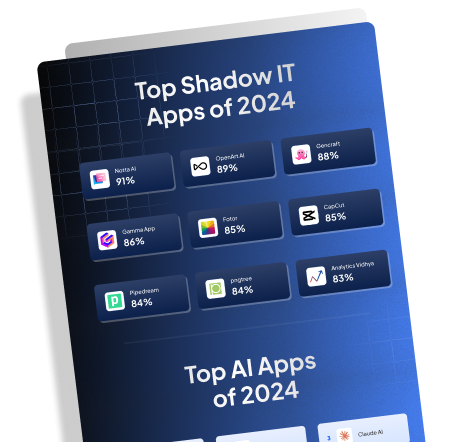Is your enterprise grappling with AI systems that seem to operate in the shadows, outside your control? The complexity of managing rogue AI elements can feel overwhelming. But fear not—our goal here is to cut through the noise and provide clear strategies to regain control. If you’re also dealing with unmanaged SaaS applications, consider exploring a SaaS Management Platform for more comprehensive oversight.
What Is Shadow AI?
Shadow AI refers to artificial intelligence tools and applications adopted within an organization without the explicit approval or knowledge of the IT department. This phenomenon can lead to serious security, compliance, and operational risks, making it crucial for IT departments to address and manage it effectively.
Why Is Discovery Essential?
The first step in combating shadow AI is investing in discovery tools and solutions. Platforms like Torii’s SaaS Management Platform (SMP) offer comprehensive insights into the software applications in use within an organization. By leveraging such tools, IT departments can identify unauthorized AI tools, track their usage, and assess potential risks. Thorough discovery ensures a clear understanding of the current landscape and helps in planning further actions.
How to Design a Response Plan?
Designing a response plan is the next critical step. This involves creating clear policies and procedures around the adoption and use of AI tools. The response plan should include guidelines on who can approve AI tools, the process for evaluation and onboarding, and the consequences of non-compliance. Training and awareness programs should also be conducted to educate employees about the risks associated with shadow AI and the importance of adhering to organizational policies.
What About Building a Data Map?
Building a data map is fundamental in accounting for subprocessors and other entities that might pose security or compliance threats. A comprehensive data map helps in identifying the flow of data within and outside the organization, ensuring all subprocessors are known and evaluated for compliance requirements. It also assists in the detection of potential vulnerabilities and the formulation of strategies to safeguard sensitive information.
Acknowledge the Complexity
The battle against shadow AI is complex, requiring continuous monitoring, adaptation, and collaboration across departments. Employing a mental model that considers AI governance, risk management, and stakeholder engagement can help in navigating these complexities. Frameworks like COBIT (Control Objectives for Information and Related Technologies) or ISO/IEC 38500 provide structured approaches to IT governance and risk management, making them useful in managing shadow AI concerns.
The next section will cover specific tactics and best practices to effectively manage and mitigate the risks associated with shadow AI.
Best Practices for Managing Shadow AI
Successfully combating shadow AI requires a multifaceted approach, incorporating proactive strategies, effective communication, and continuous evaluation. Here are some best practices to help your organization manage and reduce the risks associated with shadow AI:
Adopt a Holistic SMP (SaaS Management Platform)
Investing in a robust SaaS Management Platform (SMP), like Torii, is a crucial step in managing shadow AI. An SMP offers visibility into all software applications used within your organization, including those that are unauthorized. Regularly update your SMP and train your IT staff to leverage its full capabilities. This empowers your organization to maintain a complete inventory of AI tools, monitor their usage, and identify any unapproved or risky applications. Visit Torii’s website to learn more about their comprehensive SMP solutions.
Implement Strict Access Controls
Limiting access to AI tools based on roles and responsibilities is another key practice. Ensure that only authorized personnel with specific needs can deploy AI applications. Use multi-factor authentication (MFA) and role-based access controls (RBAC) to enforce these restrictions. Regularly review and update user access privileges to reflect changes in job roles and organizational structure.
Maintain Detailed and Up-to-Date Documentation
Develop and maintain comprehensive documentation of all approved AI tools and their use cases. This should include information on data sources, processing methods, and compliance considerations. Detailed documentation aids in transparency and accountability, making it easier to detect deviations and ensure alignment with organizational policies.
Set Up Regular Audits and Monitoring
Regular audits and ongoing monitoring are essential for detecting and mitigating shadow AI. Establish a schedule for periodic audits of your AI tool inventory and usage patterns. Utilize automated monitoring solutions to alert you of any anomalies or unapproved AI activities. Audits and continuous monitoring help identify and address risks before they escalate into significant issues.
Foster a Culture of Compliance and Awareness
Creating a culture of compliance and awareness is vital for mitigating shadow AI risks. Conduct regular training sessions to educate employees about the dangers of shadow AI and the importance of adhering to established protocols. Encourage open communication channels for employees to report suspected use of unauthorized AI tools. Recognize and reward compliance to reinforce positive behavior.
Establish Clear Reporting Mechanisms
Implement clear and straightforward reporting mechanisms for shadow AI detection and issues. Ensure that employees know how and where to report any concerns or irregularities related to AI usage. Swift and transparent reporting enables prompt investigation and resolution, thus minimizing potential risks.
Engage Stakeholders in Governance
AI governance should involve input from diverse stakeholders, including IT, legal, compliance, and business units. Create cross-functional teams to oversee AI tool approvals and policy enforcement. This collaborative approach ensures that all perspectives are considered and that AI governance is robust and comprehensive.
Leverage Frameworks and Standards
Utilizing established frameworks and standards, such as COBIT or ISO/IEC 38500, can guide your organization’s approach to IT governance and risk management. These frameworks provide structured methodologies to evaluate and manage the risks associated with AI tools, facilitating more effective control over shadow AI.
By implementing these best practices, organizations can significantly reduce the risks posed by shadow AI. A strategic, informed, and holistic approach to AI management ensures that your organization remains secure
